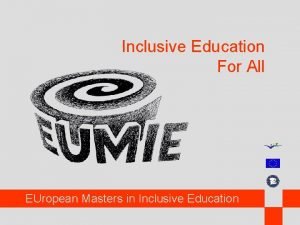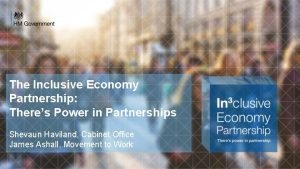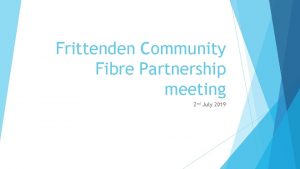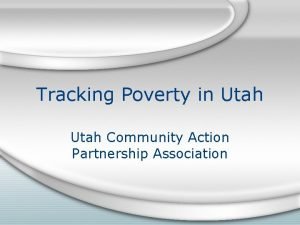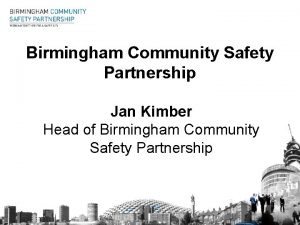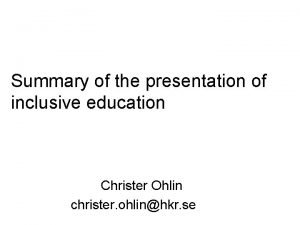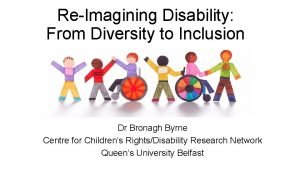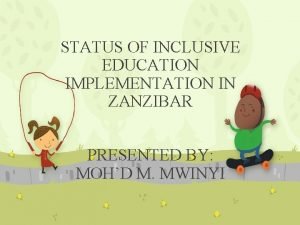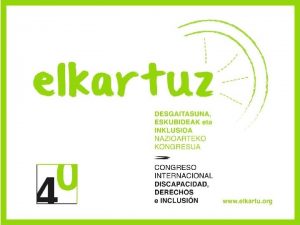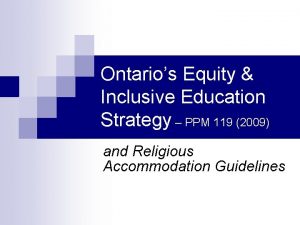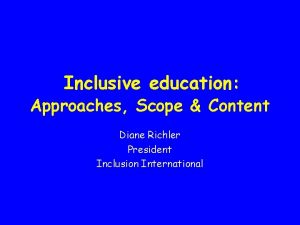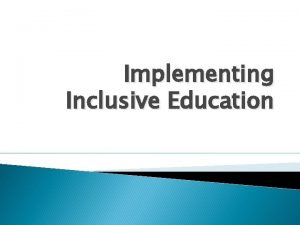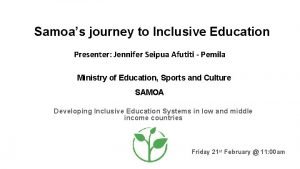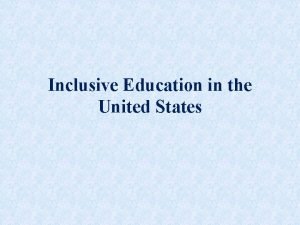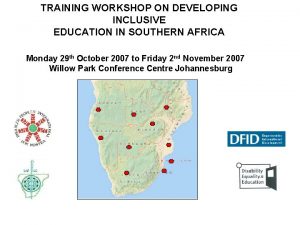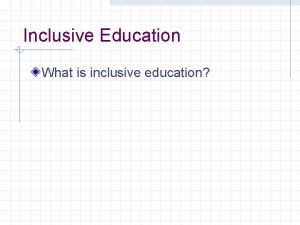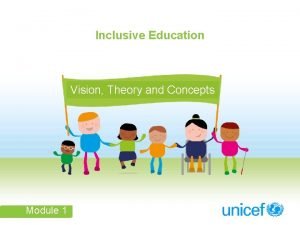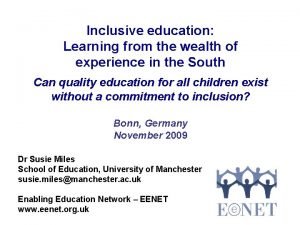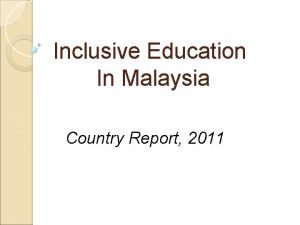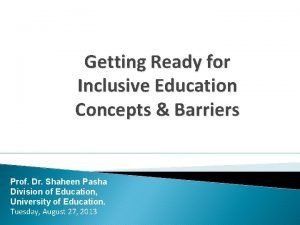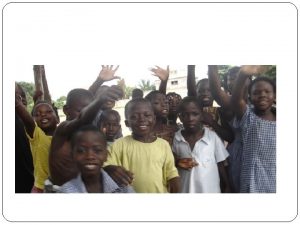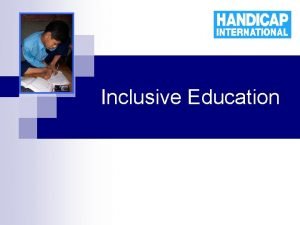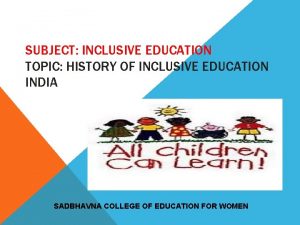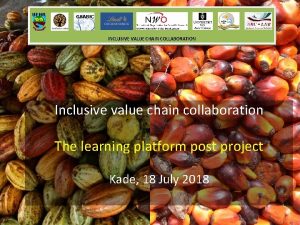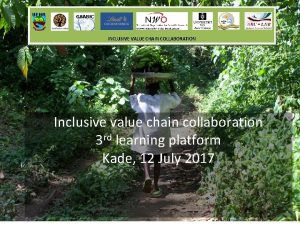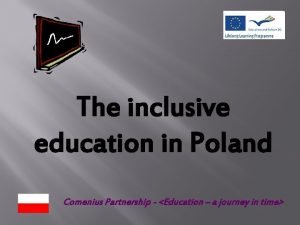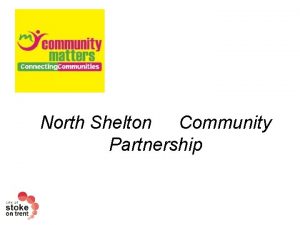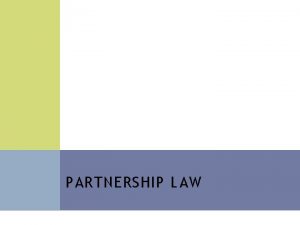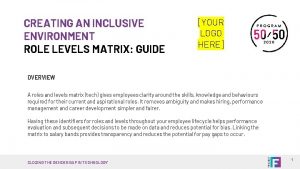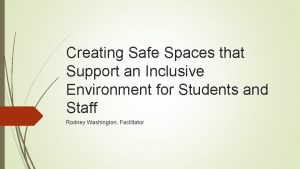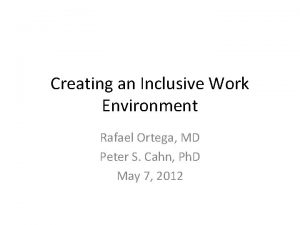Creating an Inclusive Environment Inclusive Education Community Partnership
























- Slides: 24

Creating an Inclusive Environment Inclusive Education & Community Partnership Kristin Hoefflin, MFT, BCBA August 18, 2013

What is Inclusion? * *The following slides on Inclusion were adapted from a presentation prepared by IECP Founder & Director, Rick Clemens (2013).

Basic Premise… �When it comes to including individuals with special needs into age-appropriate, natural and inclusive environments, one can create 100 reasons why it is not possible… � He’s not ready � Not fair to the other students/people � Nobody would want to hire her � There already homes/places for people like that � He is a biter

…Or you can decide it is important enough and make it work!!!

Basic Presumptions �Individuals can be included regardless of their ability and/or functioning level �There is no “cookie cutter” approach to including individuals �Individuals with special needs can learn incidentally from their peers and will model behavior given the right learning environment and interventions

Where Can Inclusion Occur? �School (all grade levels) �Play Dates �Community Activities �Community Associations �Community Events �Family Functions �Living Arrangements �Work EVERYWHERE!!!

Match Environment Person

Addressing Inclusion Concerns �“The child with special needs will not get the specialized attention he/she needs to learn” �“The other children in the environment will suffer”

Planning & Preparation �For the adults �For the person with ASD or other disorder �For the peers �Of the environment

Planning for Adults �Three most important components are: �COLLABORATION �Collaboration between adults occurs before the individual is included into the environment and ongoing while the individual is included in the environment

Collaboration Between Adults Includes: �A team consisting of a minimum of: �The leader of the inclusive environment (e. g. teacher, coach, counselor, employer, program staff, etc. ) �A “expert” on the individual being included and on inclusion principles (e. g. parent/caregiver, agency staff, YOU!!) �The individual being included (if appropriate) �A review of the individual �Strengths, challenges and needs �Creation of goals for the individual in the environment �Development of necessary strategies for success

Development Communication & BRAINSTORMING Evaluation Implementation

Planning for the Individual �Most important components include: �Priming �Observation �Teaching

Priming �Priming of the environment (visits, pictures, videos, discussion) �Priming of the people (visits, pictures, discussion) �Priming of the schedule (visuals, rehearsal, discussion) �Priming of the activities and materials (visits, concrete objects, discussion) All priming should include positive connections to the individual’s past experiences

Observation �Observation of the individual in the environment in which they are included on a regular and ongoing basis �Observation of the other people in the environment and the similarities and differences between their behavior/ functioning/performance and that of the individual with special needs

Teaching �Teaching of the actual skills involved in the activity and/or related skills to maximize active participation in the activity or environment �Teaching occurs both during the activity as well as outside of the activity or environment (before and after)

Strategies for Activity Adaptation What is the rest of the class/group doing? What is the activity and what are the expected learning outcomes? 2. What are the desired learning outcomes for the youth? What are the youth’s goals? What are the youth’s strengths? 3. Choose the least restrictive, most appropriate activity adaptation level from the hierarchy listed below: 1.

�As Is: Can the youth do what the rest of the group is doing without any adaptations? �Adapt Materials or Rules: Can the youth do what the rest of the group is doing with the use of adaptive materials and rules? �Multi-Level Curriculum: Can the youth work within the activity, but from a different level of mastery? �Curriculum Overlapping: Can the youth be involved in the same activity as the rest of the group, but have a learning outcome from a different area? (e. g. social vs. skill mastery). �Substitute Curriculum: Have the youth work on an alternative activity that meets his/her needs in an appropriate and functional way.

Planning for Peers �In regards to planning for the peers, the most important components include: �EDUCATION �The more knowledgeable they are, the more helpful they will be!

Peer Education & Ability Awareness �An understanding that we all have unique strengths and challenges �A discussion of the different members of the environment’s strengths and challenges �An understanding of the individual with special need’s strengths and challenges leading to an acceptance of the individual as a person �An understanding of what they can do to assist each other with their challenges (team building and team responsibility

Planning the Environment �Identify potential challenges �Identify opportunities for success �Identify necessary adaptations �Set up the environment for success as part of the planning and collaboration process

Addressing Challenging Behavior �ALL children exhibit challenging behavior �Positive praise �Whenever possible, rely on natural consequences in the environment �Premack Principle �Planned Ignoring

Inclusion Provides Opportunities for All!

Questions & Comments
 Inclusive education and community partnership
Inclusive education and community partnership Inclusive education and community partnership
Inclusive education and community partnership Inclusive economy partnership
Inclusive economy partnership Creating an english environment
Creating an english environment Kaiser permanente value compass
Kaiser permanente value compass Community fibre partnership
Community fibre partnership Utah community action head start
Utah community action head start Birmingham community safety partnership
Birmingham community safety partnership Inclusive education conclusion
Inclusive education conclusion Reimigining disability and inclusive education
Reimigining disability and inclusive education Achievement of inclusive education in zanzibar
Achievement of inclusive education in zanzibar Reimigining disability and inclusive education
Reimigining disability and inclusive education Ppm 119
Ppm 119 Diane richler
Diane richler Unesco inclusive education
Unesco inclusive education Inclusive education policy
Inclusive education policy What is this photo
What is this photo Objectives of inclusive education
Objectives of inclusive education Conclusion of special education
Conclusion of special education Aims and objectives of inclusive education
Aims and objectives of inclusive education Objectives of inclusive education
Objectives of inclusive education Inclusive education definition
Inclusive education definition Disadvantages of inclusive education slideshare
Disadvantages of inclusive education slideshare Acrostic poem for mixture
Acrostic poem for mixture Definition of inclusive education by authors slideshare
Definition of inclusive education by authors slideshare

